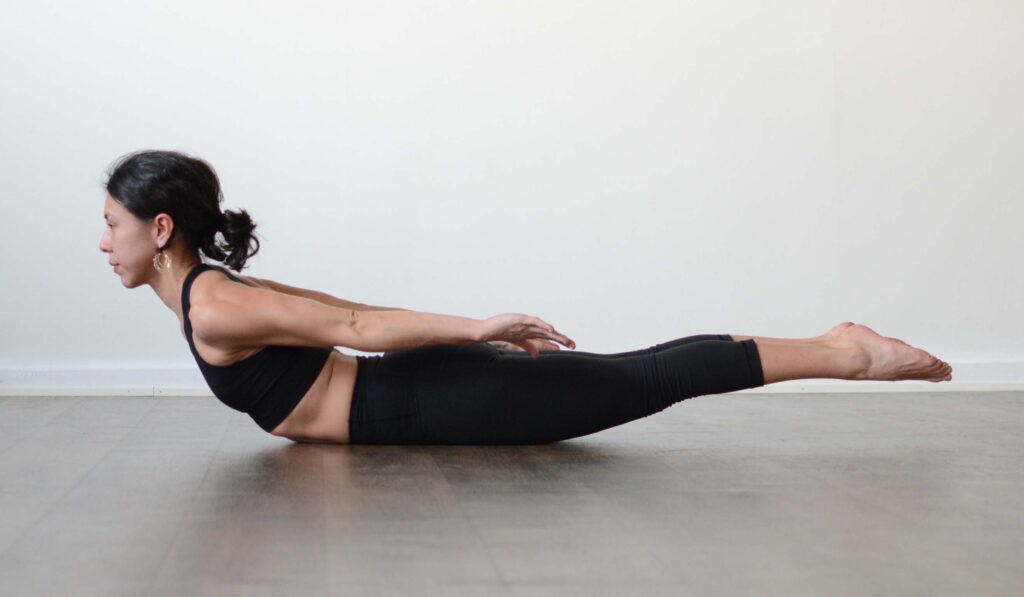Salabhasana Yoga: Elevate Your Strength and Energize Your Spirit with Locust Pose
Table of Contents
Introduction
Salabhasana Yoga, also known as Locust Pose, is an empowering and energizing yoga posture that strengthens the back, improves posture, and activates the entire body. Derived from the Sanskrit words “salabha” (meaning locust) and “asana” (meaning pose), Salabhasana resembles the shape of a locust lifting off the ground, symbolizing resilience, vitality, and the ability to overcome obstacles.
In this article, we will delve into the steps, benefits, variations, and precautions associated with Salabhasana, enabling you to incorporate this invigorating pose into your yoga practice.
How to Perform Salabhasana Yoga
To practice Salabhasana Yoga, follow these step-by-step instructions:
Step 1: Lie down on your belly with your forehead resting on the mat and your arms alongside your body, palms facing up.
Step 2: Bring your legs together, with the tops of your feet pressing firmly against the mat.
Step 3: Engage your core muscles and gently tuck your tailbone to lengthen your lower back.
Step 4: On an inhale, lift your head, chest, and arms off the mat, maintaining a gentle gaze forward or slightly upward.
Step 5: Continue to lift your legs off the mat, pressing the tops of your feet together and actively reaching your toes backward.
Step 6: Keep your neck relaxed and your shoulder blades drawn toward each other.
Step 7: Hold the pose for 20-30 seconds, breathing deeply and maintaining a strong and stable body.
Step 8: Exhale and gently release the pose, lowering your head, chest, arms, and legs back to the mat.
Benefits of Salabhasana Yoga
Regular practice of Salabhasana Yoga offers a multitude of physical and mental benefits, including:
a. Strengthened Back Muscles: Locust Pose targets and strengthens the muscles of the back, including the erector spinae, promoting better posture and alleviating back pain.
b. Improved Core Strength: The engagement of the core muscles in Salabhasana helps to develop a strong and stable center, enhancing overall strength and stability in the body.
c. Toned Leg Muscles: As you lift your legs off the mat, Salabhasana engages the muscles of the thighs and buttocks, promoting toned and strengthened lower body muscles.
d. Increased Spinal Flexibility: The extension of the spine in Locust Pose enhances spinal flexibility, counteracting the effects of prolonged sitting and improving overall mobility.
e. Enhanced Digestion: The gentle compression of the abdomen in Salabhasana stimulates the digestive organs, supporting healthy digestion and alleviating digestive issues.
f. Boosted Energy and Vitality: The uplifting nature of Locust Pose energizes the body and mind, invigorating the nervous system and promoting a sense of vitality and rejuvenation.

Variations of Salabhasana Yoga
Explore these variations of Salabhasana to add variety and challenge to your practice:
a. Half Locust Pose: Lift one leg at a time, keeping the other leg grounded on the mat. This variation allows you to focus on individual leg strength and balance.
b. Superman Pose: Extend your arms forward as you lift your chest, arms, and legs off the mat. This variation intensifies the engagement of the back muscles and challenges the entire body.
c. One-Legged Locust Pose: Lift one leg off the mat while keeping the other leg grounded. This variation emphasizes core stability and increases the workload on the lifted leg.
Precautions and Contraindications
While Salabhasana Yoga is generally safe for most practitioners, it’s important to consider the following precautions:
a. Avoid Salabhasana Yoga if you have a recent or chronic back injury or any condition that restricts movement in the spine. Seek guidance from a healthcare professional or an experienced yoga instructor.
b. If you have high blood pressure or a heart condition, consult with your doctor before practicing Locust Pose, as the pose involves an inversion of the body.
c. Pregnant women should avoid Salabhasana Yoga or modify the pose by keeping the legs closer together and avoiding excessive strain on the abdomen.
Conclusion
Salabhasana Yoga, the Locust Pose, empowers you to embrace strength, vitality, and resilience in your yoga practice. By incorporating this invigorating posture regularly, you can strengthen your back, improve your posture, and ignite your energy.
Approach Salabhasana with mindfulness and listen to your body’s signals, adjusting the pose to suit your individual needs. Allow the spirit of the locust to inspire you as you soar to new heights of strength and vitality in Salabhasana, embracing the transformative power of this uplifting pose.





